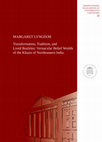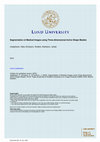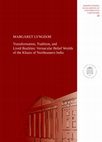Papers by Margaret Lyngdoh
BRILL eBooks, Dec 19, 2023
Indigenous Religious Traditions, Dec 20, 2023
Routledge eBooks, Jul 3, 2023

Väitekirja elektrooniline versioon ei sisalda publikatsioone.Folkloristlikel välitöödel põhinev v... more Väitekirja elektrooniline versioon ei sisalda publikatsioone.Folkloristlikel välitöödel põhinev väitekiri keskendub Kirde-Indias elava khasi rahva usundilise pärimuse erinevatele ilmingutele (demonoloogia, maagilised transformatsioonid, surmakultuur). Töös analüüsitakse jutumaailma vastastikuseid suhteid ühiskondliku ja religioosse tegelikkusega. Valitud üksikteemades avalduvad sotsiaalne marginaliseerimine ning põliskultuuri ja moderniseeruva linnakultuuri konfliktid, samuti kogukondlikku identiteeti toetav kultuuri enesepeegeldus suhetes teiste etniliste rühmadega. Ühtlasi analüüsib väitekiri erinevaid sotsiaalseid mehhanisme, mis aitavad khasidel ühtaegu hoida omakultuuri ja seejuures kohaneda modernsuse ja kristlusega. Ühiskonna ja üleloomuliku maailma vastastikused suhted on keerukad, hõlmates nii argielu kui ka inimpsühholoogiat, millega seotud kujutelmad pole stabiilsed, vaid muutuvad ajas. Väitekirjas on lähemalt uuritud jutupärimust haihtuvast hääletajast ja thlen’ist kui i...

Religious Studies and Theology, 2017
In this paper a fully automated segmentation system for the femur in the knee in Magnetic Resonan... more In this paper a fully automated segmentation system for the femur in the knee in Magnetic Resonance Images and the brain in Single Photon Emission Computed Tomography images is presented. To do this several data sets were segmented manually. The resulting structures were first represented by unorganised point clouds. With level set methods surfaces were fitted to these point clouds. The iterated closest point algorithm was then applied to establish correspondences between different surfaces. Both surfaces and correspondences were used to build a three dimensional statistical shape model of the major bones in the knee. The resulting model is then used to automatically segment structures in subsequent data sets through three dimensional Active Shape Models. The result of the segmentation is promising, but the quality of the segmentation is dependent on the initial guess.
The Khasis are an ethnic community in Northeast India numbering about 1.2 million. The majority o... more The Khasis are an ethnic community in Northeast India numbering about 1.2 million. The majority of them are Christian converts who belong to two main denominations, the Presbyterians and the Catholics. The Thlen tradition of the Khasis represents belief in a demonic spirit who is satiated with human blood and in return gives wealth and good fortune to his keepers. Narrated as a folktale, this traditional practice assumes significance when beliefs embedded in the narrative are enacted in the social discourse of the Khasis. This article examines belief performance; it explores how the Thlen belief and narrative is used to create social division and justify ostracism, murder, othering and demonization.

This article argues that genre markers employed in oral narratives about possession by water spir... more This article argues that genre markers employed in oral narratives about possession by water spirits serve to exemplify human / non-human relations in Khasi supernatural ontology. It is not the aim of this work to add to the existing corpus of theories on narrative genre studies, but to try to analyse how genre boundaries within the Khasi language help shape and articulate relationality, interaction and participation between humans and entities of water. The article elucidates the way in which the “supernatural” world is understood and mediated through the mechanism of fear and its absence, as manifested in the narratives. Through case studies collected during primary fieldwork from various interlocutors from different parts of the Khasi and Jaintia Hills, attitudes towards entities identified as sourced from the Khasi traditional religion help to create and shape the “new” frames of Christianity, urbanisation and modernity within which these entities operate.
Asian Ethnology, 2012
This article on the vanishing hitchhiker theme explores how an international narrative has genera... more This article on the vanishing hitchhiker theme explores how an international narrative has generated a locally constructed set of orally transmitted narratives. The narratives derive from the framework of traditional belief systems among the Khasi community in northeastern India and incorporate within them Western conceptions of hauntings and beliefs about the restless dead. The article also attempts to examine how this narrative critiques paradigm shifts in the socioeconomic structures that are dependent on government policies and infrastructural development. Alongside this analysis, the article further explores how the urban legend is supported by the living Khasic system of belief and social reality.

Article III Lyngdoh, Margaret (forthcoming). Tiger Transformation Among the Khasis of Northeaster... more Article III Lyngdoh, Margaret (forthcoming). Tiger Transformation Among the Khasis of Northeastern India: Belief Worlds and Shifting Realities. Anthropos 111 (2). Article IV Lyngdoh, Margaret (forthcoming). Spirit Propitiation and Corpse Re-animation: Belief Negotiations Among the Khasis of Northeastern India. In: Marion Bowman and Ülo Valk (eds.), Contesting Authority: Vernacular Knowledge and Alternative Beliefs. Sheffield: Equinox Publishing Ltd. further realized that the marginalisation and manipulation of the Khasi communities living in the peripheral areas of the Khasi Hills is a strategy of the dominant religious and political institutions-and that it is in no way accurate to view oral culture and indigenous religion as markers of "primitive" thought patterns or intelligence. I am very grateful for all of the insights that my doctoral research has granted me. The years that I have spent in Tartu have been a learning experience. Several individuals are responsible for guiding me, and I acknowledge them to be my super-heroes. Firstly, I acknowledge Ülo Valk, my very patient supervisor, mentor, and friend, who believed in me so much that I, too, began to have faith in myself. Next, my parents Sadik Lyngdoh and Gabrielle W. Lyngdoh, who trusted fate and sent me into (at the time) an unknown country. I acknowledge the great help of Laur Järv, my husband, who had the (mis)fortune to marry me: you supported me every single time. I want to thank my sister Aldalin Lyngdoh for all the computers she has bought for me; it is also fortunate that you work in a library, because without you, I do not know how I would have accessed the literature that I have. Claire Scheid, dear friend and colleague with whom I discussed so many research questions: thank you also for helping me with language editing. I thank Damang Syngkon, my friend and translator who has been there with me from the very beginning of it all. Thank you Ergo-Hart Västrik for your close reading of this text and for your insightful comments. I am additionally indebted to all my colleagues in the Department of Estonian and Comparative Folklore who have helped me, learned to eat spicy Indian food with me, and, most of all, have always been there for me when times got rough-thank you Merili, Pihla, Anastasiya, Maili, Liilia and Indrek Peedu. I would like to thank the Centre for Folklore Studies, Ohio State University, for allowing me to be a visiting scholar. In particular, I thank Amy Shuman (my teacher and mentor at OSU), Dorothy Noyes (who kindly gave me her office to use), and Cassie Patterson. I acknowledge also the kindness of the Study of
Layout and cover design: OÜ Intelligent Design Cover photo: Sarlongkiri Ingti. This photo was tak... more Layout and cover design: OÜ Intelligent Design Cover photo: Sarlongkiri Ingti. This photo was taken in 2016 during the Karbi Youth Festival, held annually in Karbi People's Hall, Taralangso (Diphu, Karbi Anglong). It depicts the Karbi Rongketong, a traditional procession on the opening day of the festival. Rongketong is usually a custom carried out during the Karbi three-day ritual called Chomkan.

Asienforum, 2018
This article argues that genre markers employed in oral narratives about possession by water spir... more This article argues that genre markers employed in oral narratives about possession by water spirits serve to exemplify human / non-human relations in Khasi supernatural ontology. It is not the aim of this work to add to the existing corpus of theories on narrative genre studies, but to try to analyse how genre boundaries within the Khasi language help shape and articulate rela-tionality, interaction and participation between humans and entities of water. The article elucidates the way in which the "supernatural" world is understood and mediated through the mechanism of fear and its absence, as manifested in the narratives. Through case studies collected during primary fieldwork from various interlocutors from different parts of the Khasi and Jaintia Hills, attitudes towards entities identified as sourced from the Khasi traditional religion help to create and shape the "new" frames of Christianity, urbanisation and modernity within which these entities operate.
This article is based on primary fieldwork carried out between 2012 and 2017 in Chyrmang, Jaintia... more This article is based on primary fieldwork carried out between 2012 and 2017 in Chyrmang, Jaintia Hills. Among the Pnar of Jaintia Hills, Northeastern India, the practice of hiar blai or divine possession is significantly embedded in the everyday lives of the community members. I argue that possession rites mediate and regulate social norm and clan justice, through the intercession of the gods and goddesses in the village. The reflexive nature of fieldwork process sought to demonstrate the non-absolute positionality of the researcher, and informants and attempted to find ways how to articulate informant’s voices while at the same time protecting their identities.
Abstract
The Khasis are an ethnic community in Northeast India numbering about 1.2 million.
The m... more Abstract
The Khasis are an ethnic community in Northeast India numbering about 1.2 million.
The majority of them are Christian converts who belong to two main denominations,
the Presbyterians and the Catholics. The Thlen tradition of the Khasis represents
belief in a demonic spirit who is satiated with human blood and in return gives
wealth and good fortune to his keepers. Narrated as a folktale, this traditional
practice assumes significance when beliefs embedded in the narrative are enacted in
the social discourse of the Khasis. This article examines belief performance; it explores
how the Thlen belief and narrative is used to create social division and justify
ostracism, murder, othering and demonisation.
Keywords
Khasi, Thlen, belief, narrative, other, demonization, Christianity, India

This article on the vanishing hitchhiker theme explores how an international narrative has genera... more This article on the vanishing hitchhiker theme explores how an international narrative has generated a locally constructed set of orally transmitted narratives. The narratives derive from the framework of traditional belief systems among the Khasi community in northeastern India and incorporate within them Western conceptions of hauntings and beliefs about the restless dead. The article also attempts to examine how this narrative critiques paradigm shifts in the socioeconomic structures that are dependent on government policies and infrastructural development. Alongside this analysis, the article further explores how the urban legend is supported by the living Khasic system of belief and social reality. keywords: vanishing hitchhiker-belief narratives-matrilineal societyurban legends-restless dead twenty-three-year-old pregnant woman was killed by her husband; on 8 January 2008 he was sentenced to life imprisonment. 1 Soon afterwards, the story of a young woman hailing taxis, and then vanishing mysteriously from them, began to make the rounds in Shillong.
Thesis Chapters by Margaret Lyngdoh

Beginning with the understanding, that belief in the supernatural expresses itself in multiple fo... more Beginning with the understanding, that belief in the supernatural expresses itself in multiple folkloric manifestations, this thesis sought to document traditions about the revenant, narratives about the blood-seeking non-human, human-animal transformations and the after-life culture of the Khasi ethnic community in North Eastern India. But the research process of documentation through fieldwork led to several questions related with the multiple articulations of belief. Accordingly, this thesis makes an attempt to analyse the storyworld of the Khasis, and it’s intersections with their social and religious reality. It presents a case study seen from the context of marginalisation, the indigenous heritage and conflicted intentions where belief becomes suggestive of a community’s need to come to terms with it’s own place alongside other ethnic identities. This thesis also looks at the various social mechanisms that are employed toward a reconciliation with modernity and Christianity whilst retaining a sense of what it means to be Khasi. The outcome is a hybrid interaction between religion, society, and the supernatural realm in the everyday life which is not fixed, but which accommodates shifting belief and notions about the self and personhood. Accordingly, narratives of the vanishing hitchhiker and the non-human Thlen were collected in order to examine the functions they perform in the context of the matrilineal social structure and the highly urbanised, modern environment of Shillong city. The analyses showed how the existing structures in society were subverted as a result of the circulation of the revenant narratives. The consequences of the circulation of “dark”, and malicious folklore often lead to the loss of life, mob violence and “othering” of groups of people within Khasi society. In the peripheral areas of the Khasi Hills, the phenomenon of human-animal transformations revealed the ability of culture to adapt to changing circumstances, and sustain itself through narratives. Significant aspects that are discussed in depth comprise the strategies of meaning-making in the context of the discourse of encounters: the preservation of indigenous beliefs is made possible through their demonisation by the Khasi Christian Church. This thesis does not arrive at a homogenised, coherent conclusion about contemporary Khasi society; rather it looks at the multivalent nature of folk beliefs and narratives, and presents a non-linear, layered glimpse into the life ways of the community.
Talks by Margaret Lyngdoh











Uploads
Papers by Margaret Lyngdoh
The Khasis are an ethnic community in Northeast India numbering about 1.2 million.
The majority of them are Christian converts who belong to two main denominations,
the Presbyterians and the Catholics. The Thlen tradition of the Khasis represents
belief in a demonic spirit who is satiated with human blood and in return gives
wealth and good fortune to his keepers. Narrated as a folktale, this traditional
practice assumes significance when beliefs embedded in the narrative are enacted in
the social discourse of the Khasis. This article examines belief performance; it explores
how the Thlen belief and narrative is used to create social division and justify
ostracism, murder, othering and demonisation.
Keywords
Khasi, Thlen, belief, narrative, other, demonization, Christianity, India
Thesis Chapters by Margaret Lyngdoh
Talks by Margaret Lyngdoh
The Khasis are an ethnic community in Northeast India numbering about 1.2 million.
The majority of them are Christian converts who belong to two main denominations,
the Presbyterians and the Catholics. The Thlen tradition of the Khasis represents
belief in a demonic spirit who is satiated with human blood and in return gives
wealth and good fortune to his keepers. Narrated as a folktale, this traditional
practice assumes significance when beliefs embedded in the narrative are enacted in
the social discourse of the Khasis. This article examines belief performance; it explores
how the Thlen belief and narrative is used to create social division and justify
ostracism, murder, othering and demonisation.
Keywords
Khasi, Thlen, belief, narrative, other, demonization, Christianity, India